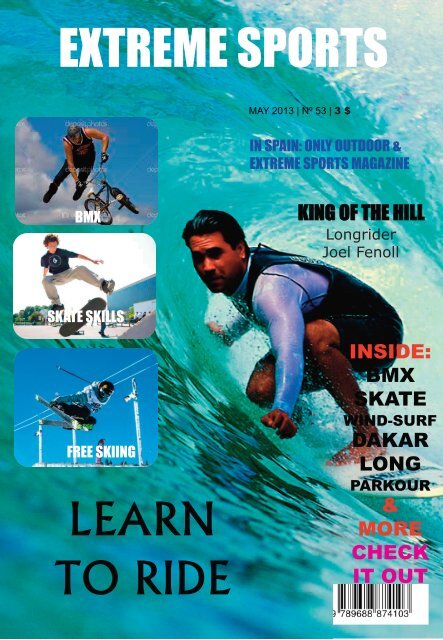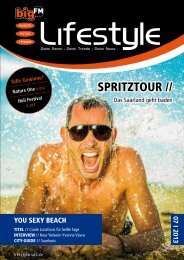EXTREME SPORTS LEARN TO RIDE
EXTREME SPORTS LEARN TO RIDE
EXTREME SPORTS LEARN TO RIDE
You also want an ePaper? Increase the reach of your titles
YUMPU automatically turns print PDFs into web optimized ePapers that Google loves.
<strong>EXTREME</strong> <strong>SPORTS</strong><br />
BMX<br />
SKATE SKILLS<br />
FREE SKIING<br />
<strong>LEARN</strong><br />
<strong>TO</strong> <strong>RIDE</strong><br />
MAY 2013 | Nº 53 | 3 $<br />
IN SPAIN: ONLY OUTDOOR &<br />
<strong>EXTREME</strong> <strong>SPORTS</strong> MAGAZINE<br />
KING OF THE HILL<br />
Longrider<br />
Joel Fenoll<br />
INSIDE:<br />
BMX<br />
SKATE<br />
WIND-SURF<br />
DAKAR<br />
LONG<br />
PARKOUR<br />
&<br />
MORE<br />
CHECK<br />
IT OUT
SUMMARY<br />
In this editon of Extreme Sports, we<br />
want you to see a diferent way of vision<br />
of this variety of Sports with a special<br />
risk, and many adrenaline.<br />
Well, this week, we want show you<br />
Xtreme Sports which we are very sure it<br />
will like you so much. In this editon, you<br />
will be read about sports like Skate, Long-<br />
Board,MuaiThay,Surfing,WindSurf,Apnea,<br />
WingSuit,SnowBoard,BMX RED BULL,<br />
Puentng, Rally Dakar, Parkour and Raftng.
index<br />
Skate (Konrad)______________________Pag 1<br />
Long (Konrad)_______________________Pag 2<br />
Muay Thai (Konrad)__________________Pag3/4<br />
Surf (Konrad)________________________Pag 5/6<br />
Windsurf (Konrad)____________________Pag 7/8<br />
Apnea (Dani)________________________Pag 9/10<br />
Wingsuit (Dani)______________________Pag 11/12<br />
Snowboard (Dani)____________________Pag 13/14<br />
Bmx (Dani)__________________________Pag 15<br />
Red Bull Rampage (Dani)______________Pag 16<br />
Puenting (Guille)_____________________Pag 17/18<br />
Dakar (Guille)_______________________Pag 19/20<br />
Parkour (Guille)______________________Pag 21/22<br />
Rafing (Guille)_______________________Pag 23/24
Skateboarding was first started in<br />
the 1950s, when all across Califor-<br />
nia surfers got the idea of trying<br />
to surf the streets. No one really<br />
knows who made the first board -<br />
- instead, it seems that several<br />
people came up with similar ideas<br />
at the same time. Several people<br />
have claimed to have invented<br />
the skateboard first, but nothing<br />
can be proved, and skateboarding<br />
remains a strange spontaneous<br />
creation.<br />
SKATE<br />
These first skateboarders started<br />
with wooden boxes or boards<br />
with roller skate wheels slapped<br />
on the bottom. Like you might<br />
imagine, a lot of people got hurt<br />
in skateboarding's early years! It<br />
was a sport just being born and<br />
discovered, so anything went. The<br />
boxes turned into planks, and<br />
eventually companies were pro-<br />
ducing decks of pressed layers of<br />
wood -- similar to the skateboard<br />
decks of today. During this time,<br />
1<br />
skateboarding was seen as some-<br />
thing to do for fun after surfing.<br />
In 1963, skateboarding was at a<br />
peak of popularity, and compa-<br />
nies like Jack's, Hobie and Ma-<br />
kaha started holding<br />
skateboarding competitions. At<br />
this time, skateboarding was<br />
mostly either downhill slalom or<br />
freestyle.<br />
With the evolution of skateparks<br />
and ramp skating, the skateboard<br />
began to change. Early skate<br />
tricks had consisted mainly of<br />
two-dimensional freestyle mano-<br />
euvres like riding on only two<br />
wheels ("wheelie" or "manual"),<br />
spinning only on the back wheels<br />
(a "pivot"), high jumping over a<br />
bar and landing on the board<br />
again, also known as a "hippie<br />
jump", long jumping from one<br />
board to another, (often over<br />
small barrels or fearless teena-<br />
gers), or slalom. Another popular<br />
trick was the Bertlemann slide,<br />
named after Larry Bertelemann's<br />
surfing manoeuvres.
LONG BOARD<br />
Longboarding is the art/sport/hobby of riding<br />
a long skateboard, from 24" to 80".<br />
Longboarding has its roots in surfing, which<br />
is why many longboards resemble surf boards.<br />
Skateboarding in general evolved from<br />
surfing in the 70s. Much of the success and<br />
popularity of skateboarding is due to the<br />
west coast, where skaters would skate in<br />
empty pools. This style of skating still lives on<br />
today, but in relative obscurity. Longboarding<br />
started to become popular when these pool<br />
skaters started to age. Utilizing these longer<br />
skateboards let anyone, no matter their age<br />
or skill level, enjoy skateboarding.<br />
2
Disciplina surgida en Tailandia, la<br />
cual se desarrolló ya que ésta se<br />
hallaba constantemente en conflicto<br />
bélico con reinos vecinos<br />
como Birmania y Camboya. Por<br />
esto, la ciudad se vio obligada a<br />
que sus soldados pudieran manejar<br />
con destreza las lanzas, espadas,<br />
y la utilización del cuerpo<br />
como un arma en situaciones de<br />
combate a distancia corta. Técnicas<br />
como las patadas, golpes con<br />
el puño, rodillas, espinillas, codos<br />
y ciertas maneras de derribar al<br />
adversario, fueron desarrolladas<br />
en ese entonces. Durante este pe-<br />
MUAY-THAI<br />
riodo el muay thai era considerado<br />
como un arte esencial, y<br />
parte del currículum real para<br />
poder aspirar al trono.<br />
Durante los siglos siguientes, el<br />
arte continuó evolucionando. No<br />
fue hasta el reinado del rey Narai<br />
(1604-1690), caracterizado por<br />
ser una época de paz, cuando se<br />
convirtió en deporte profesional.<br />
Las peleas se efectuaban en un<br />
espacio delimitado, consistente<br />
en una cuerda sobre el piso formando<br />
un cuadro para indicar el<br />
área de combate. Las reglas eran<br />
simples: pelear hasta que uno<br />
3<br />
quedara de pie, o que uno de los<br />
dos se rindiera. No había limitaciones<br />
en cuanto a peso, estatura<br />
o edad, las aldeas competían unas<br />
contra otras y se efectuaban<br />
apuestas.<br />
WAI KRU<br />
Debe empezar el combate con<br />
un ritual. Este ritual consta de varios<br />
pasos o en su mayoría de varios<br />
rituales, los cuales sirven para<br />
ahuyentar a los supuestos malos<br />
espíritus para que el combatiente<br />
tenga una buena actuación y<br />
sobre todo, mantenga una conexión<br />
con los supuestos maestros.<br />
Estos supuestos maestros se<br />
dicen que existieron en la antigüedad<br />
y se deben contactar en la<br />
actualidad para no salir del cuadrilátero<br />
muerto y conservar la<br />
vida. El ritual previo al combate<br />
se llama wai kru.
MUAY-<br />
THAI<br />
4Whi?
SURF<br />
5<br />
Surfing is a surface water sport in which the<br />
wave rider, referred to as a "surfer", rides on<br />
the forward face of a wave, which is most<br />
often carrying the surfer towards shore.<br />
Waves suitable for surfing are primarily<br />
found in the ocean, but can also be found in<br />
lakes or in rivers in the form of a standing<br />
wave or tdal bore. However, modern-day<br />
surfing can also be done in man-made sources<br />
such as wave pools and boat wakes.The<br />
term "surfing" refers to the act of riding a<br />
wave and not the form (with or without a<br />
board) in which the wave is ridden. For instance,<br />
the natve peoples of the Pacific surfed<br />
waves on alaia, paipo, and other such<br />
crafts on their belly, knees, and feet. Not to<br />
menton, Bodysurfing, the act of surfing a<br />
wave without a board, is considered by<br />
some to be the purest form of surfing. That<br />
much said, the more modern day definiton<br />
of surfing tends to refer to when a surfer<br />
rides a wave standing up on a surfboard,<br />
which is referred to as stand-up surfing or<br />
paddleboarding. Although, another prominent<br />
form of surfing in the ocean today includes<br />
bodyboarding, which refers to when<br />
a surfer rides a wave either on the belly,<br />
dropknee, or stand-up on a bodyboard.
SURF<br />
6
WIND<br />
SURF<br />
Windsurfing is a surface water sport Some credit S. Newman Darby with Windsurfing can be said to strad-<br />
that combines elements of surfing the origination of windsurfing by dle both the laid-back culture of<br />
and sailing. It consists of a board 1965 on the Susquehanna River, surf sports and the more rules-<br />
usually 2 to 3 metres long, with a Pennsylvania, USA when he invenbased environment of sailing. Al-<br />
volume of about 60 to 250 liters, poted the "sailboard", which, incidenthough it might be considered a<br />
wered by wind on a sail. The rig is tally, he did not patent.In 1964, minimalistic version of a sailboat,<br />
connected to the board by a free-ro- Darby began selling his sailboards. A a windsurfer offers experiences<br />
tating universal joint and consists of promotional article by Darby was that are outside the scope of any<br />
a mast, 2-sided boom and sail. The published in the August 1965 edi- other sailing craf design. Wind-<br />
sail area generally ranges from 2.5 tion of Popular Science magazine. surfers can perform jumps, inver-<br />
m2 to 12 m2 depending on the con- While Darby's "sailboard" incorpoted loops, spinning maneuvers,<br />
ditions, the skill of the sailor and the rated a pivoting rig, it was "square and other "freestyle" moves that<br />
type of windsurfing being underta- rigged" and suffered all the associa- cannot be matched by any sailken.ted<br />
limitations.<br />
boat. Windsurfers were the first<br />
to ride the world's largest waves,<br />
such as Jaws on the island of<br />
Maui, and, with very few exceptions,<br />
it was not until the advent<br />
of tow-in surfing that waves of<br />
that size became accessible to<br />
surfers on more traditional surfboards.<br />
Extreme waves aside,<br />
many expert windsurfers will ride<br />
the same waves as wavesurfers<br />
do (wind permitting) and are<br />
themselves usually very accomplished<br />
without a rig on a conventional<br />
surfoard.<br />
7
At one time referred to as "surfing's ginger<br />
haired cousin" by the sport's legendary<br />
champion, Robby Naish,[7] windsurfing has<br />
long struggled to present a coherent image of<br />
the sport to outsiders. As a result of attempts<br />
to claim the word "windsurfer" as a trademark,<br />
participants have been encouraged to<br />
use different names to describe the sport, including<br />
"sailboarding" and "boardsailing".<br />
The term "windsurfing" has persisted as the<br />
accepted name for the sport, and the word<br />
"windsurfer" persists for both participants<br />
and equipment.<br />
Windsurfing is predominately undertaken on<br />
a non-competitive basis. Organised competition<br />
does take place at all levels across the<br />
world and typical formats for competitive<br />
windsurfing include Formula Windsurfing,<br />
speed sailing, slalom, course racing, wave sailing,<br />
superX, and freestyle. These events are<br />
exciting to watch as sailors push the limits<br />
both physically and creatively with moves<br />
that look as impossible as thinking them up<br />
in the first place.<br />
8<br />
Windsurfing, as a sport and recreational<br />
activity, did not emerge until the latter<br />
half of the 20th century. But before this,<br />
there have been sailing boats of various<br />
designs that have used wind as the driving<br />
force for millennia, and Polynesians have<br />
been riding waves for many of them, undertaking<br />
day trips over oceans standing<br />
upright on a solid board with a vertical<br />
sail.<br />
In 1948, 20-year old Newman Darby was<br />
the first to conceive the idea of using a<br />
handheld sail and rig mounted on a universal<br />
joint so that he could control his<br />
small catamaran—the first rudderless sailboard<br />
ever built that allowed a person to<br />
steer by shifing his or her weight in<br />
ordzto tilt the sail fore and af. Darby did<br />
not file a patent for the sailboard. However,<br />
he is widely recognized as its inventor<br />
as well as the first to conceive, design,<br />
and build a sailboard with a universalzjoint.<br />
In his own words, Darby experimented<br />
throughout much of the 1950s and<br />
1960s and it wasn't until 1963.Windsurfing,<br />
as a sport and recreational activity,<br />
did not emerge until the latter half of the<br />
20th century. But before this, there have
Freediving (or free-diving) is a form of underwater<br />
diving that relies on a diver's ability<br />
to hold his or her breath until<br />
resurfacing rather than on the use of a breathing<br />
apparatus such as scuba gear. Examples<br />
include breath-hold spear fishing,<br />
freedive photography, recreational breathhold<br />
diving, apnea competitions, and to<br />
some degree, snorkeling. The activity that<br />
garners the most public attention is the extreme<br />
sport of competitive apnea in which<br />
competitors attempt to attain great depths,<br />
times, or distances on a single breath.<br />
APNEA<br />
10<br />
Competitive freediving is currently governed<br />
by two world associations: AIDA International<br />
(International Association for Development<br />
of Apnea) and CMAS (World<br />
Underwater Federation). Most types of<br />
competitive freediving have in common that<br />
it is an individual sport based on the best individual<br />
achievement. An exception to this<br />
rule is the bi-annual World Championship<br />
for Teams, held by AIDA, where the combined<br />
score of the team members makes up<br />
the team's total points. There are currently<br />
nine disciplines used by official governing<br />
bodies and a dozen disciplines that are only<br />
practiced locally. In this article, the recognized<br />
disciplines of AIDA and CMAS will be<br />
described. All disciplines can be done by<br />
both men and women and, while done outdoors,<br />
no differences in the environment<br />
between records are recognized any longer.<br />
The disciplines of AIDA can be done both in<br />
competition and as a record attempt, with<br />
the exception of Variable Weight and No limits,<br />
which are both done solely as record<br />
attempts.
APNEA APNEA<br />
9
Another variation on which studies are<br />
being focused is the so-called wingpack,<br />
which consists of a strap-on rigid wing in<br />
carbon fibre.[8] It is a mix between a hangglider<br />
and a wingsuit. The wingpack can<br />
reach a glide ratio of 6 and permits transportation<br />
of oxygen bottles and other material.<br />
On 31 July 2003, the Austrian Felix Baumgartner,<br />
jumping from 29,360 ft (9 km), successfully<br />
crossed the English Channel in 14<br />
minutes using a wingpack, having covered<br />
over 35 km (21.8 mi).<br />
WING-<br />
SUIT<br />
11<br />
Wingsuit flying is the sport of flying the<br />
human body through the air using a special<br />
jumpsuit, called a wingsuit, which adds surface<br />
area to the human body to enable a<br />
significant increase in lift. Modern wingsuits,<br />
first developed in the late 1990s, create the<br />
surface area with fabric between the legs<br />
and under the arms. Wingsuits are sometimes<br />
referred to as a birdman suit (after the<br />
makers of the first commercially available<br />
wingsuit), flying squirrel suit (due to their<br />
resemblance to the animal. Squirrel is now<br />
the name of a commercial wingsuit manufacturer),<br />
or bat suit (due to their vague resemblance<br />
to the animal or perhaps the<br />
superhero).A wingsuit flight normally ends<br />
with a parachute opening. So a wingsuit can<br />
safely be flown from any point that provides<br />
sufficient altitude for flight and parachute<br />
deployment (normally a skydiving drop aircraft<br />
or BASE jump exit point).<br />
The wingsuit flier wears parachute equipment<br />
designed for skydiving or BASE jumping.
WING<br />
SUIT<br />
12
SnowBoarding<br />
Snowboarding is a winter sport that involves<br />
descending a slope that is covered with<br />
snow while standing on a board attached to<br />
a rider's feet, using a special boot set onto a<br />
mounted binding. The development of<br />
snowboarding was inspired by skateboarding,<br />
sledding, surfing and skiing. It was developed<br />
in the United States in the 1960s<br />
and became a Winter Olympic Sport in<br />
1998. In 2002 competitive snowboarders<br />
formed the World Snowboard Tour.<br />
Snowboarding has been around since the<br />
1920s, when boys and men would tie<br />
plywood or wooden planks from barrels to<br />
their feet using clotheslines and horse reins<br />
in order to steer themselves down hills. Modern<br />
snowboarding began in 1965 when<br />
Sherman Poppen, an engineer in Muskegon,<br />
Michigan, invented a toy for his daughter by<br />
fastening two skis together and attaching a<br />
rope to one end so she would have some<br />
control as she stood on the board and glided<br />
downhill.<br />
13
Shaun White<br />
Shaun Roger White is an american<br />
professional skateboarder<br />
and snowboarder.He is a<br />
two tme Olympic gold medalist.In<br />
the last eleven years he<br />
has won 28 gold medals, 6 silver<br />
medals and 3 bronce medals.<br />
Early Life<br />
White was born in San Diego, California.<br />
His ancestry includes Irish<br />
and Italian. He was born with a Tetralogy<br />
of Fallot, a congenital heart<br />
defect for which he endured two<br />
open-heart operatons before the<br />
age of one. He stands 5'8" (1.73 m)<br />
tall. White spent his formatve years<br />
riding Okemo Mountain and Bear<br />
Mountain, small ski resorts found in<br />
Ludlow, Vermont, and the San Ber-<br />
nardino Mountains of Southern California.<br />
14<br />
Snowboarding<br />
career<br />
White has partcipated in two<br />
Winter Olympics in his career. At<br />
both the 2006 and 2010 Winter<br />
Olympics, White won gold in the<br />
snowboard halfpipe event. White<br />
has also partcipated in the Winter<br />
X Games, where he has won a<br />
medal every year since 2002. Including<br />
all winter X Games compettons<br />
through 2009, his medal<br />
count stands at 15 (10 gold, 3 sil-<br />
ver, 2 bronze), among which is<br />
the first quadruple win streak by<br />
a male athlete in one discipline,<br />
the .
BMX<br />
Bicycle motocross or BMX is the sport of racing bicycles in motocross The 1972 motorcycle racing do-<br />
style on tracks which use an inline start and have obstacles, and also recumentary On Any Sunday is gefers<br />
to the bicycle itself, which is designed for dirt and motocross nerally credited with inspiring the<br />
cycling.BMX began in the early 1970s when children began racing their movement nationally in the Uni-<br />
bicycles on dirt tracks in southern California, inspired by the motocross ted States; its opening scene<br />
stars of the time. The size and availability of the Schwinn Sting-Ray and shows kids riding their Sting-Rays<br />
other wheelie bikes made them the natural bike of choice for these off-road. By the middle of that de-<br />
races, since they were easily customized for better handling and perforcade the sport achieved critical<br />
mance. BMX racing was a phenomenon by the mid-1970s. Children were mass, and manufacturers began<br />
racing standard road bikes off-road, around purpose-built tracks in Cali- creating bicycles designed espefornia.cially<br />
for the sport.<br />
George E. Esser founded the National<br />
Bicycle League as a nonprofit<br />
bicycle motocross<br />
sanctioning organization in 1974.<br />
Before they set up the NBL, Esser<br />
and his wife, Mary, sanctioned<br />
motorcycle races with the American<br />
Motocross Association<br />
(AMA). Their two sons, Greg and<br />
Brian, raced motorcycles, but also<br />
enjoyed riding and racing BMX<br />
with their friends. It was their<br />
sons’ interest, and the lack of<br />
BMX organizations in the East,<br />
which prompted Esser to start the<br />
NBL in Florida.<br />
15
Red Bull<br />
Rampage<br />
16<br />
The Red Bull Rampage is an invite-only freeride<br />
mountain bike competton held near<br />
Zion Natonal Park in Virgin, Utah, USA, just<br />
to the north of Gooseberry Mesa. Previously<br />
it was held off the Kolob Terrace Road, on<br />
the western boundary of Zion Natonal<br />
Park.[1] The competton was held from<br />
2001–2004 and then canceled due to the increasing<br />
risk compettors were taking. The<br />
Rampage however was re-introduced for<br />
the 2008 season. In 2010, the event was<br />
held October 1–3.<br />
The event is similar to freestyle skiing and<br />
snowboarding, where compettors are judged<br />
on their choice of lines down the<br />
course, their technical ability and the complexity<br />
of tricks. For the 2008 event wooden<br />
features have been introduced to what has<br />
previously been a 'Natural' only course.
Bungee jumping is an activity that involves<br />
jumping from a tall structure while connected<br />
to a large elastic cord. The tall structure<br />
is usually a fixed object, such as a building,<br />
bridge or crane; but it is also possible to<br />
jump from a movable object, such as a hotair-balloon<br />
or helicopter, that has the ability<br />
to hover. When the person jumps, the cord<br />
stretches and the jumper flies upwards<br />
again as the cord recoils, and continues to<br />
oscillate up and down until all the energy is<br />
dissipated.<br />
The highest jump<br />
In August 2005, AJ Hackett added a<br />
SkyJump to the Macau Tower, making<br />
it the world's highest jump at 233 metres<br />
(764 f).The SkyJump did not qualify<br />
as the world's highest bungee as it<br />
is not strictly speaking a bungee<br />
jump, but instead what is referred to<br />
as a 'Decelerator-Descent' jump, using<br />
a steel cable and decelerator system,<br />
rather than an elastic rope.On 17 December<br />
2006, the Macau Tower started<br />
operating a proper bungee jump,<br />
which became the "Highest Commercial<br />
Bungee Jump In The World" according<br />
to the Guinness Book of<br />
Records.
PUENTING
DAKAR<br />
The Dakar Rally is an annual Dakar Series rally raid<br />
type of off-road race, organised by the Amaury Sport<br />
Organisaton. Most events since the incepton in 1978<br />
were from Paris, France, to Dakar, Senegal, but due to<br />
security threats in Mauritania, which led to the cancellaton<br />
of the 2008 rally, the 2009 Dakar Rally was run<br />
in South America.It was the first tme the race took<br />
place outside of Europe and Africa.[1] It has stayed in<br />
South America from 2009 to the present (2013).[2][3]<br />
The race is open to amateur and professional entries.<br />
Amateurs typically make up about eighty percent of<br />
the partcipants.<br />
Despite its 'rally' name, it is an off-road endurance<br />
race, properly called a rally raid rather than a conventonal<br />
rally. The terrain that the compettors traverse<br />
is much tougher and the vehicles used are true offroad<br />
vehicles rather than the modified on-road vehicles<br />
used in rallies. Most of the compettve special<br />
sectons are off-road, crossing dunes, mud, camel<br />
grass, rocks and erg among others. The distances of<br />
each stage covered vary from short distances up to<br />
800–900 kilometres (500–560 mi) per day.The three<br />
major compettve groups in the Dakar are the motorcycle<br />
(moto) class (including quadbikes as one of<br />
the sub-classes), the car class, (which ranges from<br />
buggies to small SUVs) and the truck class.<br />
Many vehicle manufacturers exploit the harsh environment<br />
the rally offers as a testng ground and<br />
consequently to demonstrate the durability of their<br />
vehicles, although most vehicles are heavily modified<br />
or purpose built.Over 190 different countries<br />
take the internatonal feed of the event with a<br />
roundup of every day being made into a 26-minute<br />
programme. This has been commentated on by<br />
Toby Moody for ten years, but Ben Constanduros<br />
speaks on the 2011 editon.A television documentary<br />
Race to Dakar described the experiences of a<br />
team including the actor Charley Boorman in preparaton<br />
for and entry into the 2006 Dakar Rally.
In 1982, Mark Thatcher, son of the then British Prime Minister Margaret Thatcher, along with his French codriver<br />
Anne-Charlotte Verney and their mechanic, disappeared for six days. On January 9, the trio became<br />
separated from a convoy of vehicles afer they stopped to make repairs to a faulty steering arm. They were<br />
declared missing on January 12; afer a large-scale search, a Lockheed L100 search plane from the Algerian<br />
military spotted their white Peugeot 504 some 50 km (30 mi) off course. Thatcher, Verney and the mechanic<br />
were all unharmed.<br />
The organiser of the rally, Thierry Sabine, was killed when his Ecureuil helicopter crashed at 07:30 p.m. on<br />
Tuesday 14 January 1986, into a dune at Mali during a sudden sand-storm. Also killed onboard was the singer-songwriter<br />
Daniel Balavoine, helicopter pilot François-Xavier Bagnoud, journalist Nathalie Odent and<br />
Jean-Paul Lefur who was a radiophonic engineer for RTL.Six people were killed during the 1988 race, three<br />
participants and three local residents. In one incident, Baye Sibi, a 10-year-old Malian girl, was killed by a<br />
racer while she crossed a road. A film crew's vehicle killed a mother and daughter in Mauritania on the last<br />
day of the race.
PARKOUR<br />
Parkour is not widely practiced in dedicated public<br />
facilities. Although efforts are being made to create<br />
places for it, some traceurs do not like the idea as<br />
it is contradictory to Parkour's value of<br />
freedom.Traceurs practice Parkour in both rural<br />
and urban areas such as gyms, parks, playgrounds,<br />
offices, and abandoned structures.<br />
Parkou is a holistc training discipline using<br />
movement that developed out of military<br />
obstacle course training. Practtoners aim<br />
to move quickly and efficiently through<br />
their environment using only their bodies<br />
and their surroundings to propel themselves,<br />
negotatng obstacles in between.<br />
They try to maintain as much momentum<br />
as possible without being unsafe. Parkour<br />
can include running, climbing, swinging,<br />
vaultng, jumping, rolling, quadrupedal<br />
movement and more, if they are the most<br />
suitable movements for the situaton. Parkour<br />
is non-compettve. It may be performed<br />
on an obstacle course, but is usually<br />
practced in a creatve (and sometmes<br />
playful) reinterpretaton or subversion of<br />
urban spaces.Parkour involves 'seeing'<br />
one's environment in a new way, and imagining<br />
the potentalites for movement<br />
around it.Developed by Raymond Belle,<br />
David Belle, Sébasten Foucan and others<br />
in the late 1980s,Parkour became popular<br />
in the late 1990s and 2000s through films,<br />
documentaries and advertsements featuring<br />
these practtoners and others.
There is no equipment required, although practtoners<br />
normally train wearing light casual clothing like<br />
comfortable running shoes, ones that are generally<br />
light, with good grip and flexibility are<br />
encouraged.Various sport-shoes manufacturers,<br />
such as Nike, with its "Free run" shoes, have developed<br />
shoes specifically for Parkour and Freerunning;<br />
and many other companies around the world have<br />
started offering Parkour-specific products.<br />
There have been a few documentaries about Parkour<br />
on major television networks. Jump London is<br />
a 2003 documentary which explains some of the<br />
background to Parkour and culminated with Sébasten<br />
Foucan, Johann Vigroux, and Jérôme Ben<br />
Aoues demonstratng their Parkour skills. Jump<br />
London was followed by Jump Britain in 2005,<br />
which featured Foucan and Ben Aoeus.
RAFTING<br />
Rafts come in a few different forms. In<br />
Europe and Australasia, the most common<br />
is the symmetrical raft steered<br />
with a paddle at the stern. Other types<br />
are the asymmetrical, rudder-controlled<br />
raft and the symmetrical raft with<br />
central helm (oars) or Stern Mounts<br />
with the oar frame located at the rear<br />
of the raft. Rafts are usually propelled<br />
with ordinary paddles and or oars and<br />
typically hold 4 to 12 persons. In Russia,<br />
rafts are often hand made and are<br />
often a catamaran style with two inflatable<br />
tubes attached to a frame. Pairs of<br />
paddlers navigate on these rafts. Catamaran<br />
style rafts have become popular<br />
in the western United States as well,<br />
but are typically rowed instead of paddled.Below<br />
are the six grades of difficulty<br />
in white water rafting. They range<br />
from simple to very dangerous and potential<br />
death or serious injuries.<br />
Rafting or white water rafting is<br />
the challenging recreational outdoor<br />
activity of using an inflatable<br />
raft to navigate a river or other<br />
bodies of water. This is usually<br />
done on white water or different<br />
degrees of rough water, in order<br />
to thrill and excite the raft passengers.<br />
The development of this activity<br />
as a leisure sport has<br />
become popular since the mid-<br />
1970s. It is considered an extreme<br />
sport, as it can be dangerous.The<br />
modern raft is an inflatable boat,<br />
consisting of very durable, multilayeredsmall<br />
as 1.5 metres (4.9 ft)<br />
long and weigh as little as 4<br />
pounds (1.8 kg).
White water rafting can be a dangerous sport, especially if basic safety precautions are not observed. Both<br />
commercial and private trips have seen their share of injuries and fatalities, though private travel has typically<br />
been associated with greater risk.[citation needed] Depending on the area, safety regulations covering<br />
raft operators may exist in legislation. These range from certification of outfitters, rafts, and raft leaders, to<br />
more stringent regulations about equipment and procedures. It is generally advisable to discuss safety measures<br />
with a rafting operator before signing on for a trip. The equipment used and the qualifications of the<br />
company and raft guides are essential information to be considered.Like most outdoor sports, rafting in general<br />
has become safer over the years. Expertise in the sport has increased, and equipment has become<br />
more specialized and increased in quality. As a result the difficulty rating of most river runs has changed. A<br />
classic example would be the Colorado River in the Grand Canyon or Jalcomulco River in Mexico, which has<br />
swallowed whole expeditions in the past, leaving only fragments of boats. In contrast, it is now run safely<br />
by commercial outfitters hundreds of times each year with relatively untrained passengers.[1]Risks in white<br />
water rafting stem from both environmental dangers and from improper behavior. Certain features on rivers<br />
are inherently unsafe and have remained consistently so despite the passage of time. These would include<br />
"keeper hydraulics", "strainers" (e.g. fallen trees), dams (especially low-head dams, which tend to<br />
produce river-wide keeper hydraulics), undercut rocks, and of course dangerously high waterfalls. Rafting<br />
with experienced guides is the safest way to avoid such features. Even in safe areas, however, moving water<br />
can always present risks—such as when a swimmer attempts to stand up on a rocky riverbed in strong current,<br />
risking foot entrapment.
ENJOY LIFE...<br />
Son Caliu<br />
C/Castellon 40<br />
Tel:971 69 96 96<br />
Fax 971 69 95 15<br />
Hour:8:00 - 13:00<br />
The XGames is the place<br />
to be if u are a fan of extreme<br />
sports.The best of<br />
the best come here to<br />
show their skills.<br />
Come check it out at:<br />
Xgames.com<br />
Speed eating is a sport<br />
in wich participants<br />
consume large quantites<br />
of food in short in a<br />
short time period.<br />
www.KDGmagazine.com
















